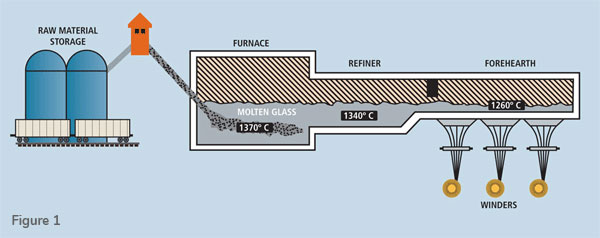Need help choosing the right product?
Our tool will match the best product to your needs
Launch product selectorWelcome to the Singapore Website
We have detected that you may prefer the Global site. Please use the language dropdown above to change your selection if required.
The Eurotherm bushing temperature control application has been specifically designed to control temperature cycling in glass fibre manufacture and has been shown to bring you:
Operation with one or two thermocouples – efficient implementation in complex control systems requiring programmed start-up of a heat sensitive process from stand-by condition.

The bushing control application offers better than 1°C resolution and can operate with one or two thermocouples, making its implementation in complex control systems requiring programmed start-up of a heat-sensitive process from stand-by condition, highly efficient.
The main aim of the control module is to control the bushing temperature under PID action, and while doing this, ensure that the physical bushing is not subject to severe changes in temperature that may damage the bushing. Figure 1 shows a typical set point profile for the bushings control module.
During normal running mode, when actually winding glass fiber onto a drum, the target temperature of the bushing is entered by the operator. This value is never changed by the control strategy and is referred to as the nominal set point. The motor automatically ramps down its speed to compensate for the increase in diameter of the drum.
When the bushing is ready for production but the variable speed motor is not winding the glass fiber onto the storage reels, a set point depression, also entered by the operator, is used by the strategy to reduce the control set point. The bushing is in a ‘background’ mode with a limited amount of fiber being produced.
After changing the winding drum, the operator can initiate a set point depression recovery. The control set point is ramped at a configurable rate from the depressed set point to the local set point value. The bushing gets reheated to normal operating temperature ready to produce another drum of fiber.
On power-up or after a power failure to the bushing heating power supply (bushing ‘cool’), the controller enters a setpoint deviation recovery mode where the control setpoint is kept close to the current process variable, then ramped to its target value. This action prevents generation of large control errors.

When the bushing is ‘cool’, the control module limits the controller output to a value selected from a break point curve depicted in Figure 2. A high limit is generated based on the current value of the process variable. The operating region is represented by the shaded area in the graph.
Glass wire manufacturing requires a high temperature stability of the draw-plate to ensure a good quality of the wire, one important parameter being a constant diameter. To obtain this stability, the temperature control is made with a Eurotherm controller giving very high stability and a thyristor stack which ensures that the right electrical power is injected into the load. This stack is a true power controller giving a constant power for a constant demand even if the resistance or the supply voltage varies.
The physical configuration of the control loop is very classical:
The final load, whose temperature must be kept constant, is the draw-plate itself -made in platinum -which has a high positive temperature coefficient for its resistance: 55 x 10-4 per °C
The cold resistance is about 8 times less than the resistance when at the correct temperature. In the cold condition the load is nearly a short-circuit. The SCR controller current limit must handle this characteristic without any damage both for the stack and the load. The stack will allow the right level of current to flow through itself and through the load requiring a fast current limit action.
When hot, the load resistance is still very low. The load supply voltage is a few volts, but the current needed to get the right power is very high: a few thousand amperes, so a steep down transformer is needed to draw the power from the 380V supply. The thyristor stack controls the transformer primary. The stack current rating needed is then only 150 Amps for up to 57 KW maximum load power, depending on draw-plate size.
To control the exact active power transferred to the load, the SCR is a Eurotherm EPower controller using a true power measurement method: Product of instantaneous values of current (I) and voltage (u).
Due to the temperature coefficient of the platinum, the transformer primary control and the high temperature stability required, the thyristor is working in phase angle firing mode. The control loop is closed by a temperature measurement on the draw-plate sent to the 2704 controller. The achieved temperature stability is 0.1°C at working temperature.
The Eurotherm controller with Digital Communication provides the facility to remotely control and supervise 75 couples of controllers/471.
To have access from the control room, where the supervisory system is installed, to the level of power delivered by each EPower controller stack, the 0-10V output power signal available on each EPower unit is sent to each associated controller on its external set point input, calibrated to 0 – 57 for 0-10V which gives a direct reading of power. The EPower instrument offers communication (TCP/IP, Modbus or Profibus): it can be connected on the communication bus. All EPower controller parameters can be available to operators in the control room; power, current, unit status, alarms etc.
Product Selector
Our tool will match the best product to your needs
Launch product selectorContact Us